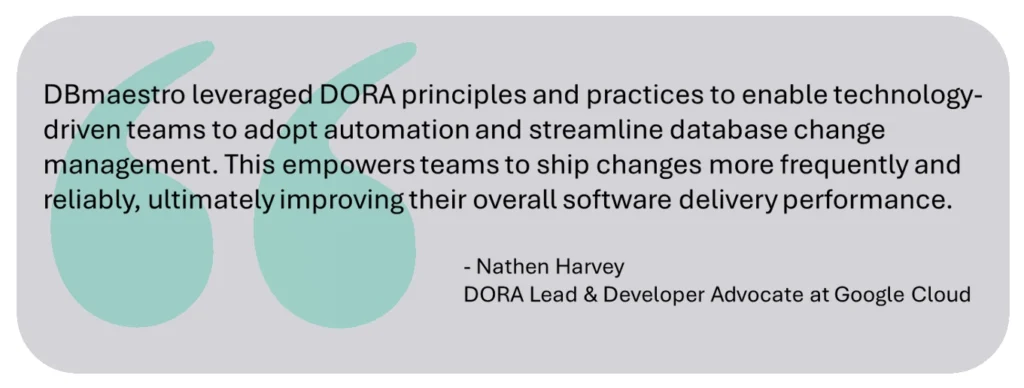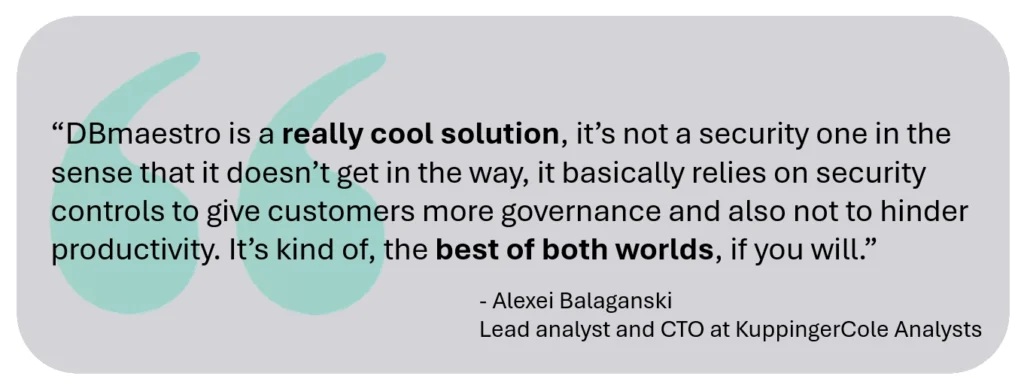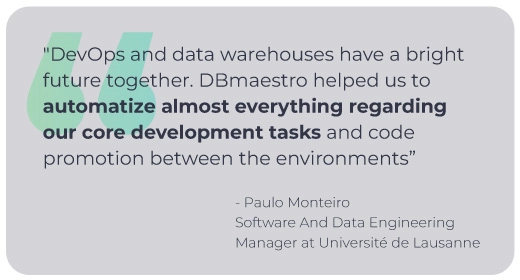“DBmaestro’s platform will support and enhance IBM DevOps, including IBM DevOps Loop, IBM DevOps Deploy and IBM DevOps Velocity. Future integrations are planned with IBM Z, HashiCorp Vault, Terraform & Waypoint, Instana, and IBM ELM to fill a critical gap in database automation and observability for enterprise DevOps toolchains.”
“The expansion from reseller to a full OEM partnership marks a pivotal moment for enterprise DevOps,” said Gil Nizri, CEO of DBmaestro. “By integrating our leading enterprise-grade multi-database DevOps platform and observability suite into IBM’s powerful suite, we are enabling organizations to orchestrate flawless software delivery from application code to database deployments. Our joint solution empowers customers to accelerate innovation, reduce risk, and maintain the highest standards of security and compliance, all while gaining real-time visibility into their database processes.”

DBmaestro automates database deployments and schema changes, eliminates the bottleneck of manual database processes, and delivers full observability into every aspect of the database DevOps lifecycle. Its integration with IBM’s DevOps tools ensures that database changes are managed alongside application code, enabling standardized deployment pipelines, robust version control, error-free automation, and actionable insights through advanced monitoring and analytics. This unified approach delivers:
– Complete DevOps Harmony: Automates the entire software delivery lifecycle, including database releases and observability for full modernization and digital transformation.
– Faster Time to Market: Enables rapid, frequent, and reliable deployments.
– Fortified Security and Compliance: Implements robust controls and visibility to meet strict regulatory requirements.
– Enhanced Software Quality: Minimizes errors and inconsistencies through automation and real-time monitoring.
– End-to-End Observability: Provides comprehensive insights into database changes, performance, and compliance across environments.
– AI Powered Insights: Automatically identifies errors and proposes ad-hoc best practices for resolution
“IBM’s mission is to help enterprises deliver innovation at scale, securely and efficiently,” said James Hunter, Program Director at IBM DevOps Automation. “By embedding DBmaestro’s industry-leading database DevOps and observability suite into our ecosystem, we are removing one of the last barriers to true end-to-end DevOps. This partnership expansion empowers our customers to achieve faster, safer, and more reliable software delivery, with unprecedented transparency into their database operations.”
The OEM agreement allows IBM customers to leverage DBmaestro’s automation and observability as a native part of their DevOps toolchain, supporting hybrid and multi-cloud environments and streamlining complex database operations.
Media contact:
Ben Gross
+972-50-8452086
beng@dbmaestro.com
]]>Enter Database DevOps—the practice of integrating database development and release into your DevOps workflow. But simply integrating is not enough. To truly build a resilient database delivery process, organizations must embrace six foundational pillars: Stability, Recovery, Reliability, Continuity, Flexibility, and Observability.
Let’s dive into each one and explore how they collectively create a bulletproof approach to database change management.

-
Stability: The Ability to Withstand Change Without Breaking
At the heart of resilience lies stability—the system’s capacity to absorb and manage change without breaking. In database DevOps, this means changes are introduced in a structured, validated, and controlled manner.
Unstable database deployments often stem from manual processes, untested scripts, environment-specific behavior, or inconsistent promotion practices. One small misstep can lead to catastrophic data loss or application failure.
How to ensure stability:
- Adopt automated validations and checks before changes are applied.
- Introduce pre-deployment staging environments to mirror production.
- Use version-controlled scripts and maintain a complete history of all schema modifications.
- Integrate static analysis and dependency checks as part of your CI/CD pipeline.
A stable database delivery pipeline ensures confidence—developers and DBAs can deploy changes without fear of breaking the system.
-
Recovery: When Things Go Wrong, Bounce Back Fast
Even with the best testing and controls, failures can still happen. That’s where recovery becomes essential. Resilience isn’t about avoiding every possible failure—it’s about being able to recover quickly when one occurs.
Database changes are particularly risky because they often involve stateful operations. A failed schema update can corrupt data or render an application unusable. Recovery requires the ability to:
- Rollback changes gracefully and reliably.
- Restore previous database states without manual intervention.
- Audit what went wrong and prevent recurrence.
Modern database DevOps platforms like DBmaestro provide checkpointing, automated rollbacks, and visibility into every change. This enables teams to respond to failures within seconds—not hours.
Why it matters:
Recovery isn’t just about fixing problems—it’s about protecting uptime, reducing customer impact, and keeping development velocity high despite setbacks.
-
Reliability: Consistent Behavior Through Every Release
Reliability is the promise that the system behaves the same way every time a change is introduced, across every environment—dev, test, staging, and production. It’s the antidote to “it worked on my machine.”
Unreliable database deployments cause headaches for developers, QA, and operations. Inconsistent behavior leads to failed tests, bugs in production, and longer release cycles.
What drives reliability in Database DevOps:
- Environment consistency through Infrastructure as Code (IaC) and repeatable setup processes.
- Promotion pipelines that treat dev, test, and production environments with equal rigor.
- Validation gates that enforce consistency at each step.
- Drift detection to identify when environments diverge unintentionally.
When your database release pipeline is reliable, every deployment is a non-event—not a fire drill.
-
Continuity: Keep Systems Running, Even During Change
Change is inevitable. Outages are not.
The goal of continuity is to ensure services stay up and running while database changes are being applied. This is especially critical for organizations with 24/7 operations or global customer bases.
Risks to continuity in the database:
- Blocking locks during migrations
- Long-running scripts that freeze the system
- Downtime during schema refactoring
- Failed scripts that halt critical processes
How to maintain continuity:
- Schedule low-risk windows based on real observability data.
- Apply canary deployments for database changes.
- Automate pre-change impact analysis to assess risk before deployment.
Continuity isn’t about moving slowly—it’s about moving safely and intelligently, ensuring the business keeps running even as the system evolves.
-
Flexibility: Adapting to Change Without Losing Control
Business requirements evolve. Architectures shift. Teams grow. New regulations appear.
Your database delivery process must be flexible enough to accommodate change while still maintaining control. Inflexible systems slow innovation and frustrate teams; overly permissive systems open the door to chaos.
Flexibility in Database DevOps includes:
- Supporting multiple database types (Oracle, SQL Server, PostgreSQL, etc.)
- Managing multiple environments and pipelines simultaneously.
- Enabling role-based access controls so different teams can work in parallel.
- Allowing custom workflows and approval gates based on your organization’s needs.
The key is striking a balance: allow for freedom where needed, but enforce control where required. Platforms like DBmaestro enable this by combining governance with configurable automation.

-
Observability: Know What Changed, Where, When, and Why
You can’t control what you can’t see.
Observability is the pillar that ties all the others together. Without it, failures are mysterious, recovery is slow, and teams are blind to the ripple effects of change.
Database observability includes:
- Change tracking: Who made what change, and when?
- Impact analysis: What else was affected?
- Policy violations: Were rules or approvals bypassed?
- Risk mitigation : Were risky or unauthorized actions detected early?
- Metric correlation: Did performance degrade after a change?
It’s not just about dashboards—it’s about context. Observability enables teams to connect the dots between change and outcome, so they can respond, adapt, and improve.
Real-world example:
A schema change in production triggers an outage. Without observability, teams scramble for hours. With observability, they identify the change in seconds, roll back automatically, and diagnose root cause instantly. That’s the difference between chaos and control.
 Final Thoughts: Resilience Checklist — Powered by DBmaestro
Final Thoughts: Resilience Checklist — Powered by DBmaestro
To thrive in today’s fast-moving DevOps world, your database delivery process must be resilient—built on six essential pillars: Stability, Recovery, Reliability, Continuity, Flexibility, and Observability.
Here’s how DBmaestro checks every box:
 Stability
Stability
Prevent systems from breaking under change.
 Version-controlled deployments
Version-controlled deployments Policy-based enforcement
Policy-based enforcement Built-in quality checks
Built-in quality checks Promotion across controlled, consistent environments
Promotion across controlled, consistent environments
 Recovery
Recovery
Bounce back fast when something goes wrong.
 Automatic rollback points
Automatic rollback points One-click undo of schema and config changes
One-click undo of schema and config changes Full deployment history for traceability
Full deployment history for traceability Rapid remediation workflows
Rapid remediation workflows
 Reliability
Reliability
Ensure consistent behavior across all environments.
 Drift detection and prevention
Drift detection and prevention Environment alignment via promotion pipelines
Environment alignment via promotion pipelines Template-based deployments
Template-based deployments Repeatable, governed processes
Repeatable, governed processes
 Continuity
Continuity
Keep services running, even during updates.
 Safe deployment orchestration
Safe deployment orchestration Pre-deployment risk assessments
Pre-deployment risk assessments Approval flows and execution control
Approval flows and execution control
 Flexibility
Flexibility
Adapt to change without losing control.
 Multi-DB support (Oracle, SQL Server, PostgreSQL, etc.)
Multi-DB support (Oracle, SQL Server, PostgreSQL, etc.) Role-based access and team-specific permissions
Role-based access and team-specific permissions Customizable workflows and release gates
Customizable workflows and release gates Seamless integration with existing toolchains (Jenkins, Azure DevOps, Git, etc.)
Seamless integration with existing toolchains (Jenkins, Azure DevOps, Git, etc.)
 Observability
Observability
See everything. Understand everything.
 DORA based performance matrix – how well are you actually doing?
DORA based performance matrix – how well are you actually doing? End-to-end change tracking (who, what, when, where)
End-to-end change tracking (who, what, when, where) Drift and anomaly detection dashboards
Drift and anomaly detection dashboards Audit-ready logs for compliance
Audit-ready logs for compliance Insights into deployment performance and release trends
Insights into deployment performance and release trends
With DBmaestro, your organization gains more than tooling—it gains the foundation for true resilience in database DevOps.
 Fewer failures
Fewer failures
 Faster recoveries
Faster recoveries
 Continuous improvement
Continuous improvement
 Safer, smarter change management
Safer, smarter change management
Your database doesn’t have to be a risk—it can be your DevOps advantage.
]]>
ignoring database DevOps isn’t just a missed opportunity—it’s an accumulating liability. The cost of doing nothing isn’t always visible on a balance sheet, but it materializes through operational inefficiencies, missed release targets, security gaps, and the erosion of confidence across delivery teams.
The Inaction Tax
Every time a developer manually applies a schema change to production without tracking, approval, or rollback procedures, the organization assumes risk. Not just the risk of failure, but the risk of not knowing what changed, who changed it, or how to undo it when something breaks. This lack of traceability leads to slow root cause analysis, misaligned teams, and reactive firefighting.
The cost here isn’t measured in currency alone—it’s measured in momentum. When deployment pipelines are halted to investigate failed scripts or unexpected data loss, it impacts everyone: developers, testers, release managers, compliance officers. Downtime might be short-lived, but the ripple effect delays business outcomes.
Worse still is the loss of predictability. When you can’t trust your environments to behave the same way, or rely on reproducibility from test to production, you’re left flying blind. This lack of confidence forces teams to over-engineer safeguards, duplicate environments, or run extensive manual validations—a drain on focus and creativity.
Invisible Waste
One of the most dangerous aspects of database operations without DevOps practices is how normalized the inefficiency becomes. Teams accept long change approval cycles, manual script review boards, and ambiguous responsibilities as “just the way it is.” But under the surface, valuable engineering hours are being diverted to low-value activities: revalidating changes, fixing promotion errors, or waiting for access permissions.
These distractions degrade productivity. Developers are pulled away from delivering business features to babysit deployments or patch rollbacks. QA teams chase phantom bugs that stem from environment drift rather than application logic. Release managers negotiate across disconnected systems, often relying on spreadsheets to track change readiness.
None of this feels urgent until there’s an incident. Then, suddenly, leadership wants to know why rollback isn’t instant, why audit logs are incomplete, or why the last change wasn’t reviewed. In that moment, the cost of doing nothing becomes painfully clear.

Fragmentation and Shadow Ops
Without a standardized database DevOps framework, teams tend to create their own workarounds. Some keep change scripts in local folders; others use makeshift version control or undocumented shell scripts. This fragmentation leads to tool sprawl, inconsistent practices, and unintentional policy violations.
Shadow operations increase audit complexity and undermine collaboration. When one team handles changes differently than another, coordination across geographies or squads becomes harder. Even worse, well-meaning engineers may bypass governance controls to “unblock” progress, inadvertently opening up security vulnerabilities or compliance gaps.
From a CIO perspective, this represents a breakdown in enterprise architecture. Instead of a unified delivery pipeline, the organization has a patchwork of manual checkpoints and tribal knowledge. That makes scaling, onboarding, and even external certification audits more difficult and costly.
Slower Time to Market
In the world of digital products and competitive feature releases, delay is its own form of cost. When database changes are not integrated into CI/CD pipelines, release candidates stall. Manual approvals, untested dependencies, and non-reproducible environments slow down iteration speed.
This results in misalignment between development and business objectives. Features are ready, but the database changes lag behind. Teams wait on DBAs, DBAs wait on scripts, and customers wait for value. It may not be classified as downtime, but it’s certainly lost momentum.
In a product-led organization, such latency isn’t just a technical issue—it’s a strategic bottleneck. Over time, it erodes competitive differentiation and frustrates stakeholders.
Compromised Security and Compliance
Security isn’t just about encryption or firewalls. It’s about knowing what’s changing, where, and by whom. When database changes are applied outside a controlled, auditable pipeline, even minor oversights can lead to major exposure.
From a governance standpoint, the lack of visibility into change history undermines compliance with internal policies and external regulations. During audits, this translates to last-minute scrambles to reconstruct change activity. In highly regulated industries, this can put certifications at risk.
Moreover, inconsistent deployment practices increase the likelihood of human error. Accidentally dropping a table, misconfiguring a permission, or applying test logic to production isn’t just inconvenient—it can be catastrophic. And the more environments, teams, or geographic regions you have, the higher the risk surface.

Opportunity Cost and Innovation Fatigue
When engineering energy is spent chasing down inconsistencies, resolving deployment issues, or building custom rollback tools, that same energy is unavailable for innovation. Teams working under chronic inefficiency tend to burn out faster, innovate less, and defer process improvements.
The opportunity cost of inaction isn’t just the downtime you avoided or the release you delayed. It’s the backlog you couldn’t clear, the automation you never built, and the product insights you never tested. It’s the new markets you didn’t reach because your team was bogged down by process debt.
In strategic planning meetings, it’s easy to focus on new initiatives. But as any CIO knows, you can’t build high-velocity systems on brittle foundations. And manual database change processes are among the most brittle of all.
The Case for Change: DBmaestro
DBmaestro provides a unified solution to these challenges. By integrating database change management into your DevOps pipelines, it brings discipline, visibility, and automation to an area that has long been left behind.
What makes DBmaestro unique is its balance between flexibility and control. It allows teams to move fast, but within boundaries. Database changes become trackable, auditable, and governed by policy. You know who made each change, why, and when. You can approve them in context, and roll them back instantly if needed.
Beyond the core automation, DBmaestro enables cross-environment consistency through drift detection and environment promotion workflows. It ensures that what you test is what you deploy—reducing surprises and increasing confidence.
Security is baked in. You can define sensitive operations, block risky commands in production, and apply RBAC at a granular level. Whether you’re subject to internal audits or external compliance mandates, you have full traceability built into every step.
And perhaps most importantly, DBmaestro provides observability into your database delivery. You can measure release velocity, failure rates, and cycle time for database changes. This allows you to benchmark progress and identify where to improve.
Final Thought: Choose Progress Over Paralysis
The cost of doing nothing about database DevOps isn’t a line item—it’s a drag on your entire delivery capability. It’s the invisible tax you pay in slow releases, fragmented teams, and reactive incident response. It’s what keeps you from delivering better, faster, and safer.
Inaction may feel safe in the short term, but over time, it compounds risk, increases toil, and puts your competitiveness at risk.
As a CIOs and DevOps leaders, your role is to empower teams with the tools and practices that unlock their potential. Database DevOps isn’t optional. It’s essential.
And the longer you wait, the more it costs.
]]>But here’s a less popular stat: 85% of AI projects fail to deliver meaningful results. Gartner said it. So did Capgemini. VentureBeat estimates that 80% of AI models never make it into production.
That’s not just a hiccup. That’s a warning.
And it’s not because the algorithms are bad or the data scientists aren’t smart enough. It’s because the foundation beneath the AI is shaky—and in many cases, it’s broken.

 Why Are So Many AI Projects Failing?
Why Are So Many AI Projects Failing?
Let’s cut through the noise: AI doesn’t magically work just because you plugged in a fancy model or bought a GPT license. It only works when the data it relies on is solid, structured, and trustworthy.
But in most enterprises, the data landscape is anything but that.
Here’s what it usually looks like:
- Customer info lives in sales-force-automation SW.
- Financials are in ERP .
- Marketing data runs through marketing automation platform.
- Product analytics sit in Datawarehouse or in a scattered data lake.
None of these systems talk to each other properly. And they weren’t designed to. ERP, SFA, SCM, and other enterprise applications were built to optimize their own functional silos—not to integrate seamlessly across the business.
To avoid disrupting these mission-critical systems, organizations rarely touch the operative data directly. Instead, they build data warehouses or data marts—replicated environments meant to unify data and adapt it to business needs. It sounds good in theory.
But in practice, this introduces a new problem: the “Sisyphean task” of constantly trying to keep up with upstream changes.
Every IT system evolves—schemas change, columns shift, data types get updated. That means keeping the warehouse aligned with the source systems is an endless, error-prone process. As a result, what feeds your AI is often out of sync, outdated, or misaligned with reality.
So you end up training AI models on mismatched bricks with no cement—data that was copied from production systems but no longer matches them. The structure rises… but not for long.
This is the quiet, invisible reason why so many AI initiatives start strong and then fall apart in production. They were built on a foundation that couldn’t keep up.
 It’s the Data Infrastructure, Not the Model
It’s the Data Infrastructure, Not the Model
If there’s one thing that keeps coming up in conversations with tech leads and CIOs, it’s this: we underestimated how hard it is to manage data properly.
The infrastructure behind AI—the data pipelines, the schema management, the release workflows—was treated as a back-office issue. But AI has pushed it front and center.
Here’s the brutal truth: You can’t automate intelligence if you haven’t automated your data integrity.
That means:
- Clean, governed database schemas
- Versioned, trackable database changes
- Security built in from the start
- A way to see what changed, when, and by whom
All of that falls under one name: Database DevSecOps.
 Database DevSecOps: The Missing Layer in Most AI Projects
Database DevSecOps: The Missing Layer in Most AI Projects
In the app world, DevOps has become second nature. You wouldn’t dream of releasing code without automated testing, version control, or CI/CD pipelines.
But databases? That’s often still manual SQL scripts, emailed approvals, and zero rollback plans.
And guess what those databases feed? Your AI.
Here’s what happens when you skip database DevSecOps:
- A schema changes in production. Nobody tells the AI team.
- An ETL pipeline breaks because a column was renamed.
- A junior dev accidentally pushes test data into prod.
- Compliance flags fly because there’s no audit trail for who changed what.
And then people wonder why the AI model gives strange predictions, misclassifies customers, or fails audits.
 So How Do You Fix It?
So How Do You Fix It?
Start by treating your database like the first-class citizen it is. That’s where tools like DBmaestro come in.
DBmaestro isn’t just a release automation tool. It’s a way to bring discipline and visibility to the one part of the stack that often gets ignored: your database.

 How DBmaestro Helps AI Projects Succeed
How DBmaestro Helps AI Projects Succeed
Let’s break it down.
- Everything Is Versioned and Automated
No more surprise changes. Schema updates go through pipelines just like application code. If something breaks, you know when it happened—and you can roll it back.
- Security and Compliance Are Built In
DBmaestro enforces policies: no unauthorized changes, no accidental drops, full traceability. That means your data science team isn’t operating on an unstable or non-compliant backend.
- You Get Real Observability
Want to know if a failing AI model is linked to a change in the database? You’ll have the logs, metrics, and policy alerts to investigate it.
- Smart Recommendations
With AI-powered insights (yes, we use AI to help AI), DBmaestro can flag risky changes before they hit production. You’ll see what slows you down, what breaks pipelines, and how to improve.
- It Works Across Clouds and Environments
Whether you’re hybrid, all-cloud, or something in between, DBmaestro can plug into your stack without friction. Oracle, PostgreSQL, SQL Server—we speak their language.
 A Quick Real-World Example
A Quick Real-World Example
A fintech company we spoke to had a fraud detection model trained on transaction data. Performance dropped suddenly.
The culprit? A column in their schema had been deprecated, but nobody told the AI team. The model was reading incomplete data.
After implementing DBmaestro, they got:
- Automated schema tracking
- Alerts when core tables changed
- Versioned rollback capabilities
The model was retrained on correct, verified data—and accuracy jumped back up.
 Final Thought: Don’t Start with AI. Start with the Ground Floor.
Final Thought: Don’t Start with AI. Start with the Ground Floor.
You wouldn’t build a skyscraper on sand. And you shouldn’t build an AI initiative on a fragile, undocumented, manually managed database.
Yes, AI is powerful. Yes, it can transform your business. But only if the data foundation is strong.
Database DevSecOps is that foundation.
And DBmaestro is how you build it—with control, with confidence, and with the kind of transparency your AI needs to thrive.
TL;DR:
- Most AI projects fail not because of the models—but because of the data infrastructure.
- Database DevSecOps brings the automation, governance, and security your AI stack needs to function properly.
- DBmaestro makes database changes safe, trackable, and scalable—so your AI models work the way they should.
Don’t chase the shiny stuff until you’ve secured the basics.
Start with your data. Start with the database.
Build your foundation before you build your future.
Information Technology General Controls (ITGC) are the backbone of any organization’s IT compliance strategy. They are a critical component in ensuring that IT systems operate reliably, securely, and in alignment with regulatory requirements. Auditors rely on ITGC to evaluate the integrity of an organization’s technology environment, particularly when assessing financial reporting, data confidentiality, and operational resilience.
ITGC serve as broad, organization-wide policies and procedures governing:
- Access to Programs and Data – Ensuring only authorized individuals have appropriate access.
- Change Management – Governing how changes to systems are requested, reviewed, approved, and implemented using automation and CI/CD.
- Program Development and Implementation – Ensuring systems are developed in a controlled, documented, and secure manner.
- Computer Operations – Including backup, recovery, job scheduling, and monitoring to maintain service continuity and reliability.
While these controls apply across the IT stack, one area consistently under-addressed is the database layer, which serves as the source of truth for business-critical operations. Unfortunately, traditional CI/CD pipelines often leave the database outside the loop—resulting in compliance gaps, operational risks, and audit findings.
This is where DBmaestro steps in.
The Role of the Database in ITGC
Databases are the heartbeat of enterprise systems. They store financial data, customer records, compliance logs, and operational intelligence. Despite their criticality, database changes are often managed manually or semi-manually—via scripts passed through email, shared folders, or loosely governed version control systems.
This inconsistency introduces serious ITGC concerns:
- Lack of traceability: Who changed what, when, and why?
- No approval workflows: Were changes reviewed and authorized?
- No rollback mechanisms: What happens when a deployment fails?
- No separation of duties: Can developers deploy directly to production?
To remain ITGC-compliant, organizations must bring the database under the same rigorous governance that already exists for application code. That’s not just best practice—it’s increasingly mandated by auditors and regulatory bodies.

Where CI/CD Meets ITGC – And the Database Gap
Modern DevOps pipelines are built around automation and agility. CI/CD frameworks such as Jenkins, Azure DevOps, and GitLab allow teams to rapidly deliver features and fixes. But while application code changes are automatically built, tested, and deployed with version control and approvals baked in, database changes remain a blind spot.
This creates a paradox: DevOps accelerates innovation, but unmanaged database changes can sabotage ITGC compliance.
Here’s how the core ITGC areas intersect with CI/CD and where the database fits in:
- Access Controls
CI/CD platforms manage who can push code and trigger pipelines. Similarly, database changes must be subject to access control mechanisms—ensuring least-privilege principles and auditable user actions.
- Change Management
CI/CD pipelines excel at managing application changes. But without similar automation for database changes, organizations fall short of ITGC expectations. Every database update must be versioned, tested, reviewed, and approved within an automated, traceable process.
- Development and Implementation
Changes in production must flow through a documented, secured SDLC process. For applications, this is often done via Git workflows. For databases, if changes are still done manually, the integrity of the SDLC is compromised.
- Operations and Monitoring
CI/CD provides visibility into build and deployment logs. But for true ITGC compliance, monitoring must extend to database deployments: failure rates, rollback actions, policy violations, and more.
DBmaestro: Enabling ITGC Compliance from the Ground Up
DBmaestro is a purpose-built database DevSecOps platform that automates, governs, and secures database change management processes—making them compliant with ITGC requirements. Its unique capabilities bridge the gap between CI/CD and regulatory-grade database governance.
Let’s examine how DBmaestro addresses each ITGC domain.
 1. Access Controls
1. Access Controls
Challenge: Ensuring that only authorized personnel can initiate and approve database changes.
DBmaestro’s Solution:
- Role-Based Access Control (RBAC): Assign granular roles to users—developers, DBAs, release managers—with clearly defined privileges.
- Environment-Based Segmentation: Prevent developers from deploying directly to production; enforce change requests to flow through proper channels.
- Audit Trails: Every user action is logged, providing auditors with a complete, tamper-proof history.
ITGC Benefit: Strong, auditable access control mechanisms aligned with least-privilege principles.
 2. Change Management
2. Change Management
Challenge: Making sure every database change is versioned, tested, reviewed, and approved.
DBmaestro’s Solution:
- Database Version Control: Changes are managed in Git, just like application code.
- Automated Deployments: CI/CD integration allows DBmaestro to apply changes automatically across environments, using approved scripts only.
- Change Approval Workflows: Integrate with Jira, ServiceNow, and other ITSM tools to ensure that no unapproved change reaches production.
- Drift Detection: Detect and resolve configuration drift between environments to ensure consistency.
ITGC Benefit: Full change lifecycle management with approvals, auditability, and consistency—meeting audit and compliance expectations.

 3. Program Development and Implementation
3. Program Development and Implementation
Challenge: Making sure database changes follow a secure, structured SDLC.
DBmaestro’s Solution:
- Dev-Test-Prod Pipelines: Enforce structured deployments across environments, with validations and rollback capabilities.
- Dry-Run (Pre-Deployment Impact Analysis): Pretest deployment to detect broken dependencies, conflicts, and potential errors before changes are applied.
- Policy Enforcement Engine: Block deployments that violate corporate policies—e.g., dropping tables in production.
ITGC Benefit: Changes follow a repeatable, governed path from development to production, with validations at every stage.
 4. Computer Operations
4. Computer Operations
Challenge: Ensuring operational resilience, visibility, and rollback capabilities.
DBmaestro’s Solution:
- Deployment Automation: Scheduled, consistent deployments across hybrid environments—on-prem and cloud.
- Rollback Mechanism: Built-in restore points to quickly reverse changes if needed.
- Observability Dashboards: Real-time dashboards and scorecards covering DORA metrics (deployment frequency, failure rate, MTTR, etc.).
- Alerting and Notifications: Get notified on failed deployments, policy violations, or unauthorized access.
ITGC Benefit: Transparent, resilient operations that support business continuity and fast recovery—key pillars of ITGC.
Built for the Hybrid World
Modern enterprises operate in hybrid environments—some databases in the cloud (e.g., AWS RDS, Azure SQL), others on-prem (e.g., Oracle, SQL Server). DBmaestro is architected to work across these environments with a unified control plane.
- Unified Policy Management: Define and enforce governance policies across all environments.
- Cross-Platform Support: Oracle, SQL Server, PostgreSQL, MySQL, and more.
- Seamless CI/CD Integrations: GitHub Actions, Azure DevOps, Jenkins, GitLab CI, etc.
- Secrets Management Integration: Works with Vault and other tools to manage secure access in line with ITGC expectations.
A Strategic Advantage for Audit Readiness
Auditors increasingly focus on database governance when evaluating ITGC. DBmaestro not only ensures compliance—but also reduces the time, cost, and stress of audits:
- Automated Reports: Export change logs, audit trails, and access history instantly.
- Policy Violations Dashboard: Highlight and explain non-compliant activities.
- DORA Metrics: Provide performance metrics aligned with DevOps and audit best practices.
Turning Compliance from Bottleneck to Business Enabler
As IT executives face mounting regulatory pressure—SOX, GDPR, HIPAA, PCI DSS—the database can no longer be an unmanaged zone. ITGC compliance is no longer just about policies – it’s about automated, enforceable practices across every layer of IT, including the most critical: the database.
DBmaestro provides the automation, visibility, and governance required to bring the database into your compliant CI/CD framework. It eliminates human error, ensures full traceability, and creates a proactive defence against audit risks and data breaches.
By choosing DBmaestro, you not only comply with ITGC—you build a stronger, faster, more secure DevOps process that’s ready for the hybrid future.
]]>This isn’t just a technical inconvenience. It’s a silent slope—a set of hidden challenges that slowly, and often unexpectedly, erode stability, increase risk, and stall innovation. Tools alone won’t solve this. Enterprises need a true solution: one that transforms how database changes are managed, governed, and delivered.
This is where Database DevOps comes in. And this is where DBmaestro shines.
Tools vs. Solutions: The Misconception That Stalls Progress
Enterprises are no strangers to buying tools. From source control systems to deployment frameworks, tools promise functionality, automation, and scale. But functionality doesn’t equal transformation. The presence of a tool in your stack doesn’t mean the problem it was meant to solve is truly addressed.
Many DevOps teams assume that once they’ve adopted tools like Jenkins or GitLab, they’ve “automated everything.” But if database changes are still handled through manual scripts, email approvals, or ad hoc processes, a massive gap remains. That gap isn’t technical—it’s operational. It’s strategic.
A tool provides potential. A solution delivers outcomes.
DBmaestro’s platform is not just a tool—it’s a comprehensive Database DevOps solution. It’s purpose-built by design is to eliminate the risk, inefficiency, and unpredictability that come from managing database changes outside the DevOps lifecycle.

The Slope of Database Neglect: Key Signals You Need a Solution
Even high-performing teams often miss the early warning signs. Here are the most common (and dangerous) symptoms that signal your enterprise needs a database DevOps solution—sooner rather than later.
-
Slow Release Cycles and Bottlenecks
You’ve automated app deployment, but you still wait days—or weeks—for database changes to be approved and executed. This delay undermines agility and turns the database into a bottleneck.
Why it matters:
Speed is everything. A single unaligned database change can hold back an entire application release.
DBmaestro’s Solution:
Integrates database changes directly into CI/CD pipelines, enabling controlled, auditable, and automated delivery with every app release.
-
Unexplained Outages and Rollback Headaches
Production outages caused by missed scripts, version drift, or incompatible changes are common when database changes aren’t tracked and tested like code.
Why it matters:
Outages cost real money, hurt customer trust, and create internal firefighting that damages productivity.
DBmaestro’s Solution:
Supports full database version control, impact analysis, and automatic rollbacks—reducing the risk of human error and environment drift.
-
Audit Anxiety and Compliance Gaps
Your compliance team requests a trace of who changed what and when—and the answer involves Excel files, Slack messages, and tribal knowledge.
Why it matters:
In industries like finance, healthcare, and government, this isn’t just inconvenient—it’s a regulatory risk.
DBmaestro’s Solution:
Provides full audit trails, role-based access control, approval workflows, and policy enforcement built directly into your delivery pipelines.
-
Multiple Environments, Zero Consistency
Dev, test, QA, staging, and production each have their own version of the database. Teams spend more time fixing environment mismatches than writing new code.
Why it matters:
Environment drift leads to defects, delays, and rework—undermining confidence in your delivery process.
DBmaestro’s Solution:
Ensures database consistency across all environments with automated deployments and drift prevention.
-
Siloed Teams and Frustrated Developers
Developers push application features, but must wait for DBAs to apply changes manually—or worse, work from outdated scripts. The workflow breaks down.
Why it matters:
Silos kill DevOps culture. Friction between dev and ops delays innovation and hurts morale.
DBmaestro’s Solution:
Bridges dev and DBA workflows with shared pipelines, automated validations, and collaborative governance—so teams can move together, not apart.
-
You Haven’t Experienced a Disaster—Yet
Some enterprises assume that because they haven’t faced a catastrophic database failure, they’re safe. But the absence of visible chaos doesn’t equal control.
Why it matters:
Minor oversights today grow into major failures tomorrow. When failure hits, it’s too late to start solving.
DBmaestro’s Solution:
Proactively reduces risk, enforces policies, and provides governance at every stage of the database change lifecycle—before trouble strikes.

The Enterprise Reality: Why You Need a Solution, Not Hope
Even if your tools are working today, the slope of database neglect is real. Small inefficiencies compound. Compliance requirements tighten. Development teams grow. Toolchains evolve. Complexity increases exponentially—and without a true solution, it becomes unmanageable.
A real solution doesn’t just plug in. It:
- Integrates deeply into your CI/CD pipeline.
- Adapts flexibly to your existing tools (Terraform, Vault, Jenkins, GitLab, etc.).
- Enforces governance without slowing teams down.
- Delivers measurable outcomes—speed, stability, visibility, and compliance.
That’s what DBmaestro was built for.
Why DBmaestro? A Solution That Understands the Problem
Unlike generic tools that try to bolt-on database automation as an afterthought, DBmaestro was designed from the ground up to solve this specific challenge: secure, scalable, and reliable delivery of database changes as part of the modern DevOps lifecycle.
Here’s what sets DBmaestro apart:
 1. Built-in Security & Compliance
1. Built-in Security & Compliance
Role-based access, audit logs, approval flows, and policy enforcement ensure that every change is safe, compliant, and accountable.
 2. Seamless CI/CD Integration
2. Seamless CI/CD Integration
Works natively with your pipelines, not against them—plugging into Jenkins, Azure DevOps, GitHub Actions, and more.
 3. Observability & Insights
3. Observability & Insights
Provides visibility into deployment performance and bottlenecks with DORA-like metrics, empowering leaders to continuously improve delivery processes.
 4. Version Control & Rollbacks
4. Version Control & Rollbacks
Full change tracking and rollback support prevent surprises in production and reduce rework and downtime.
 5. Support for All Major Databases
5. Support for All Major Databases
Works with Oracle, SQL Server, PostgreSQL, DB2, MongoDB, Snowflake, and more—because your database landscape is never just one engine.
Closing the Gap That Others Ignore
Let’s be clear: platforms like GitHub and Jenkins are phenomenal at what they do. But most of them focus on infrastructure and application code. They leave a blind spot: the database.
And when 20–30% of every enterprise application is database logic, leaving that part out of your delivery process is not just incomplete—it’s dangerous.
DBmaestro closes that gap. It doesn’t replace your tools. It completes them. It gives you the missing piece to deliver full-stack automation and governance—at scale.
Final Thought: You Don’t Need Another Tool. You Need a Solution.
Database DevOps isn’t a buzzword. It’s a critical capability for enterprises who want to scale delivery without scaling chaos. If your team is encountering even one of the challenges outlined here, you’re already on the slope.
And the solution isn’t another script, another policy doc, or another hope.
It’s DBmaestro.
]]>What You’ll Learn
– The critical role of regulatory compliance automation in database security
– Common security risks in traditional database management
– How automated database management improves compliance and security
– Key features of compliance automation for database security
– Best practices for implementing regulatory compliance automation
The Role of Regulatory Compliance Automation in Database Security
Regulatory compliance automation plays a crucial role in enhancing database security and ensuring adherence to various regulatory standards. By leveraging automated tools and processes, organizations can significantly reduce the risk of data breaches, unauthorized access, and compliance violations. This approach not only strengthens data protection measures but also streamlines the often complex and time-consuming task of maintaining regulatory compliance.

Common Security Risks in Traditional Database Management
Traditional database management approaches often expose organizations to various security risks:
- Human errors in configuration and access control
- Inconsistent application of security policies
- Delayed patch management and vulnerability fixes
- Inadequate monitoring and auditing capabilities
- Difficulty in maintaining up-to-date compliance documentation
These vulnerabilities can lead to data breaches, regulatory fines, and reputational damage.
How Automated Database Management Improves Compliance and Security
Automated database management significantly enhances both compliance and security through several key mechanisms:
Automating Security Policies and Access Controls
Automated database security tools enforce predefined security policies and access controls consistently across all database instances. This reduces the risk of unauthorized access and ensures that only appropriate personnel can interact with sensitive data.
Continuous Monitoring for Compliance Violations
Real-time monitoring capabilities allow organizations to detect and respond to potential compliance violations promptly. This proactive approach helps prevent security incidents before they escalate.
Automated Patch Management and Vulnerability Fixes
Automated database management systems can identify and apply necessary security patches and updates automatically, reducing the window of vulnerability to known exploits.
Key Features of Compliance Automation for Database Security
Effective compliance automation solutions for database security typically include:
- Policy enforcement mechanisms
- Real-time monitoring and alerting
- Automated risk assessment tools
- Comprehensive audit logging and reporting
- Integration with existing security infrastructure
- Automated patch management and vulnerability scanning
These features work together to create a robust, automated security framework that maintains continuous compliance and reduces the risk of data breaches.

Best Practices for Implementing Regulatory Compliance Automation in Databases
To maximize the benefits of regulatory compliance automation, organizations should follow these best practices:
Selecting the Right Compliance Automation Tools
Choose tools that align with your specific regulatory requirements and integrate seamlessly with your existing database infrastructure. Look for solutions that offer comprehensive coverage of compliance standards relevant to your industry.
Integrating Compliance Automation into DevOps Workflows
Incorporate automated compliance checks into your CI/CD pipelines to ensure that security and compliance are maintained throughout the development and deployment process. This integration helps catch potential issues early and reduces the risk of non-compliant changes reaching production environments.
Conducting Regular Compliance Audits with Automated Tools
Leverage automated auditing tools to perform regular compliance checks and generate detailed reports. This practice helps maintain a continuous state of compliance and provides valuable documentation for regulatory audits.
Key Takeaways
- Automated database security significantly reduces vulnerabilities and streamlines compliance management.
- Real-time monitoring and automated policy enforcement are crucial for maintaining continuous compliance.
- Integrating compliance automation into DevOps workflows ensures security throughout the development lifecycle.
- Regular automated audits help maintain compliance and provide necessary documentation for regulatory inspections.
Conclusion
Regulatory compliance automation is transforming the landscape of database security, offering organizations a powerful tool to protect sensitive data and meet complex regulatory requirements. By implementing automated solutions, businesses can significantly reduce the risk of data breaches, streamline compliance processes, and maintain a robust security posture.
As the regulatory environment continues to evolve and cyber threats become increasingly sophisticated, the importance of automated database security cannot be overstated. Organizations that embrace these technologies will be better positioned to protect their data assets, maintain customer trust, and navigate the complex world of regulatory compliance with confidence.
Ready to enhance your database security and streamline your compliance efforts? Explore DBmaestro’s database change management solutions to automate your security processes and ensure continuous compliance. Learn more about our Database DevOps solutions and take the first step towards a more secure and compliant database environment today.
]]>A tiny, untracked database change.
A schema inconsistency between staging and production.
A “hotfix” deployed at 2 a.m. but never documented.
These are not bold, banner-worthy errors. They are ghosted issues — silent, sneaky, and persistent.
This is database drift. And it is the very embodiment of a most common proverb:
“The DevOps is in the details.”

 The Hidden Ghost in Your DevOps Machine
The Hidden Ghost in Your DevOps Machine
In DevOps, we talk a lot about “shifting left,” about moving fast, and about automation-first culture. We build pipelines, automate testing, and monitor releases with laser focus. But when it comes to databases, many organizations are still operating like it’s 2005:
- Schema changes are emailed as SQL scripts.
- DBAs apply changes manually — sometimes directly in production.
- Version control for the database is an afterthought, if it exists at all.
- No centralized audit of what changed, when, or why.
And this is exactly how database drift creeps in. It doesn’t announce itself. It doesn’t crash your deployment pipeline with red alerts. Instead, it whispers errors into your application — slow queries, missing data, or failed tests that pass locally but break in production.
Drift is the ultimate ghost in the machine. You can’t see it until it’s already caused damage.
 Why You Can’t Fix What You Don’t Track
Why You Can’t Fix What You Don’t Track
The pain doesn’t end with the incident — that’s only the beginning. Once drift is suspected, the real nightmare begins:
- Time to Resolution balloons. Teams spend hours (or days) comparing environments, sifting through logs, and replaying deployment histories.
- Blame flies in every direction. Was it the developer? The DBA? The CI/CD tool? The patch team?
- Compliance is jeopardized. With no single source of truth, audit trails go cold. Regulators aren’t impressed by spreadsheets and manual notes.
- Trust erodes. Devs stop trusting the pipeline. DBAs stop trusting automation. Business leaders stop trusting IT to move fast.
The simple act of deploying a new feature — something that should take minutes — becomes a finger-pointing exercise that stretches into days.
Database drift is not just a technical issue; it’s an organizational liability.
 The Critical Need for Control and Consistency
The Critical Need for Control and Consistency
In highly regulated industries like finance, healthcare, and government, the implications of database drift go beyond broken features:
- Data breaches caused by untracked permissions or exposed tables
- Failed audits due to incomplete change histories
- Delayed product launches waiting on manual DB remediation
- Customer dissatisfaction from inconsistent user experiences
This is where traditional DevOps tooling falls short. Tools like Git, Jenkins, and Terraform are powerful for application code and infrastructure, but they weren’t built to manage the unique complexity of databases:
- Stateful dependencies
- Live data integrity
- Order-sensitive change execution
- Production-only schema variations
So how do you tame the devil hiding in these details?

 Enter DBmaestro: Bringing DevSecOps Discipline to the Database
Enter DBmaestro: Bringing DevSecOps Discipline to the Database
This is exactly where DBmaestro steps in — acting as both guardian and guide through the murky, error-prone world of database changes.
Think of DBmaestro as the “Policy as Code” forcefield in your software delivery pipeline — one that brings visibility, consistency, automation, and security to your most fragile layer: the database.
Here’s how it eliminates the risk of drift and shortens time-to-resolution dramatically:
-
Version Control for the Database
DBmaestro introduces Git versioning for your database schema and logic, so every change is tracked, traceable, and reproducible.
 No more “mystery changes”
No more “mystery changes”
 Rollbacks and comparisons are instantaneous
Rollbacks and comparisons are instantaneous
 Confidence in knowing exactly what version is in which environment
Confidence in knowing exactly what version is in which environment
-
Change Policy Enforcement (Policy as Code)
Before a change is ever deployed, DBmaestro enforces strict pre-deployment policies:
 Prevents unauthorized manual changes
Prevents unauthorized manual changes
 Verifies schema compatibility
Verifies schema compatibility
 Blocks risky operations (e.g., dropping critical columns)
Blocks risky operations (e.g., dropping critical columns)
 Ensures naming conventions and standards
Ensures naming conventions and standards
It’s like a firewall — but for schema changes.
-
Automated Drift Detection & Prevention
DBmaestro scans your environments and alerts on schema drift. Better yet — it can heal or roll back unauthorized changes based on your predefined rules.
 Early detection
Early detection
 Zero downtime conflict resolution
Zero downtime conflict resolution
 Reduced post-incident investigation times
Reduced post-incident investigation times
-
Database Release Automation
Releases move through your environments with controlled promotion paths — just like your application code. Each deployment is:
 Verified
Verified
 Logged
Logged
 Approved based on roles
Approved based on roles
 Consistent across dev, test, stage, and prod
Consistent across dev, test, stage, and prod
This means no more fire drills after deploying to production. Your team trusts the process because the process is automated and auditable.
-
Full Audit Trail and Compliance Visibility
For every database change, DBmaestro captures:
- Who made the change
- What was changed
- When it happened
- Where it was deployed
- Why it was approved
This isn’t just helpful for incident review — it’s gold during compliance audits.
 SOX, GDPR, HIPAA readiness
SOX, GDPR, HIPAA readiness
 One-click audit exports
One-click audit exports
 Peace of mind
Peace of mind
 Slashing Time to Resolution
Slashing Time to Resolution
Let’s circle back to the nightmare of drift:
- You know something broke.
- You suspect it’s in the database.
- You’re digging through backups, change tickets, and chat logs.
With DBmaestro in place, that entire fire drill becomes a five-minute investigation:
 Open the dashboard
Open the dashboard
 Compare schema versions between environments
Compare schema versions between environments
 Identify the unauthorized change
Identify the unauthorized change
 Revert it — or promote it — with a click
Revert it — or promote it — with a click
 Log the resolution and move on
Log the resolution and move on
Instead of hours or days, your MTTR (Mean Time to Resolution) drops to minutes. That means more time spent shipping value, and less time firefighting.
 Final Thought: Devil-Proof Your Database
Final Thought: Devil-Proof Your Database
“The devil is in the details” is more than a proverb — it’s a real-world warning for anyone responsible for delivering software at scale.
Application code has matured. CI/CD pipelines have matured. But databases? They’re often still drifting in the shadows.
DBmaestro brings those shadows into the light.
It automates the un-automated.
It secures the vulnerable.
It aligns your database delivery with your DevOps goals — so you can move fast and move safe.
Ready to exorcise the ghost of database drift?
Let us show you how DBmaestro can fortify your CI/CD pipeline and make database releases as predictable as code deployments.
 Learn more at DBmaestro.com
Learn more at DBmaestro.com
]]>
The Illusion of Convenience
Many development teams fall into the trap of managing schema changes through their application code, treating the database as an extension of business logic. Frameworks and ORM tools even encourage this pattern by auto-generating migrations and executing them at runtime. It might feel like everything is automated and tidy.
But under the surface, this approach introduces fragility, creates audit and security blind spots, and destroys operational control.
Let’s unpack the dangers.

Why It’s Bad to Change the Database from Inside the Application
-
Lack of Version Control
Database schema changes done via app code often bypass version control best practices. Unlike code changes tracked via Git, inline DB updates may not be reviewed, tested, or even documented. There’s no reliable history, no diff view, and no ability to rollback gracefully.
-
Environment Drift Becomes Inevitable
As changes silently propagate through different environments (Dev, UAT, Staging, Prod), schema versions begin to diverge. Application A might auto-apply a change in Dev that never gets correctly reflected in Prod. Suddenly, the same app behaves differently in different environments.
Without centralized tracking and promotion of DB changes, environment parity becomes a myth.
-
Increased Time to Resolution During Failures
When something breaks, root cause analysis becomes a nightmare:
- Was it the app code?
- Was it the schema?
- Was it the sequence of updates?
- Was something missed in a previous environment?
This uncertainty increases downtime and slows recovery.
If rollback is required, it’s even worse. The app may revert to a previous version, but the DB schema—already mutated—stays ahead. Now you have mismatched expectations between code and schema.
-
Breaks the Separation of Concerns
Application code should handle logic and business rules. Infrastructure and data layers, like the database schema, require a different lifecycle, cadence, and ownership model. Mixing these responsibilities leads to confusion, poor collaboration, and unreliable systems.
-
Loss of Observability
When schema changes are embedded and executed at runtime, there’s no transparent log of what changed, when, by whom, and why. This impairs security audits, compliance reporting, and change tracking—all vital in regulated environments like finance, healthcare, or government.
-
Security & Permissions Risks
Apps typically run with limited permissions for a reason. Allowing them to alter schemas implies elevated access that can be misused, accidentally or maliciously. It violates the principle of least privilege and creates unnecessary attack surfaces.

-
Rollbacks Are a Gamble
Tight coupling of schema changes and app versions makes rollbacks almost impossible:
- Rolling back the app doesn’t rollback the schema.
- Some schema changes (like drops or alterations) are not easily reversible.
- The team might not even know what to rollback, or in what order.
-
No Accountability, No Control
When every app can change the DB, there’s no single source of truth. Everyone becomes a schema contributor without oversight. That leads to conflicts, duplication, inconsistent conventions, and schema chaos.
-
Inconsistent State Across Environments
If the DB change logic lives inside the app, each environment (Dev, UAT, Prod) is vulnerable to partial or failed changes. Schema updates can succeed in one place and fail in another, leading to silent inconsistencies that manifest as edge-case bugs or data corruption.
-
Collaboration Breakdown
DBAs, testers, compliance officers, and release managers are locked out of the loop. They can’t preview, validate, or approve changes because those changes are invisible until deployed. This undermines team alignment and shared accountability.
In the Real World, Schema Changes Need to Be Managed, Not Implied
Professionally run software delivery processes treat database changes as first-class citizens:
- Version-controlled
- Tested independently
- Promoted through controlled pipelines
- Approved and auditable
That’s where dedicated tools and platforms come in.
How DBmaestro Solves This Problem
DBmaestro provides an enterprise-grade solution to everything wrong with managing schema changes via application code. It transforms chaotic, app-driven database evolution into a controlled, visible, and governed process that fits perfectly into modern DevOps.
-
Centralized Version Control for the Database
All schema changes are tracked, versioned, and approved in a standard Git repo. You get:
- Full history of every change
- Who made it, when, and why
- Ability to compare versions and see diffs
This eliminates rogue changes and enables structured change promotion.
-
Controlled Promotion Across Environments
With DBmaestro, you define the path and rules for promoting schema changes:
- From Dev ➔ Test ➔ UAT ➔ Prod
- With gates, validations, and approvals at each stage
- Ensuring that all environments stay in sync and free of drift
No more surprises when deploying to production.
-
Automatic Drift Detection and Resolution
Drift between environments is automatically detected. DBmaestro shows exactly what is different between schemas, enabling teams to:
- Reconcile discrepancies quickly
- Avoid configuration drift issues
- Restore environment parity without manual guesswork
-
Safe Rollbacks and Change Auditing
Changes deployed through DBmaestro are rollback-capable. If something goes wrong, you can:
- Instantly revert to a known good state
- See exactly what changed
- Generate audit-ready compliance reports
This drastically reduces downtime and increases system reliability.
-
Built-in Security, Governance, and Compliance
With full audit trails, role-based access controls, and policy enforcement, DBmaestro ensures:
- Schema changes meet security policies
- No unauthorized access or privilege escalation
- Compliance requirements are met without added manual overhead
-
Decouples Application and Database Deployment
By treating the schema as an independent deployable, DBmaestro allows teams to:
- Release DB updates independently
- Avoid app-schema lockstep dependencies
- Support multiple apps sharing the same database safely
This is especially critical in microservices or enterprise environments with shared data layers.
-
Enables Real DevOps for the Database
With DBmaestro, the database becomes an active participant in CI/CD pipelines. You can:
- Integrate DB changes into Jenkins, Azure DevOps, GitLab, etc.
- Run pre-flight validations and approvals
- Enforce policies as code
- Monitor schema health and delivery KPIs
This aligns database work with the same agility and control as application delivery.
Conclusion
In the real world, where teams, tools, audits, and uptime matter, you don’t change your database schema from inside the application. That shortcut leads to fragility, chaos, and risk.
DBmaestro exists to solve this exact problem—turning the database into a managed, observable, and reliable part of your DevOps process. It provides the common ground where development, operations, and compliance can finally meet.
Because in the real world, software delivery isn’t just about moving fast. It’s about moving fast with control.
]]>What Are Database Compliance Standards and Why Do They Matter?
Database compliance standards are sets of regulations and guidelines that govern how organizations handle, store, and protect sensitive data. These standards are critical for several reasons:
- Data Security: They ensure that proper security measures are in place to protect sensitive information from unauthorized access and breaches.
- Privacy Protection: Compliance standards safeguard individuals’ privacy rights by regulating how personal data is collected, used, and stored.
- Regulatory Compliance: Adhering to these standards helps organizations avoid legal penalties and reputational damage.
- Trust Building: Demonstrating compliance builds trust with customers, partners, and stakeholders.
Understanding Database Compliance Standards
Several key database compliance regulations exist globally, each with specific requirements:
- GDPR (General Data Protection Regulation): Protects EU citizens’ personal data and privacy.
- HIPAA (Health Insurance Portability and Accountability Act): Safeguards medical information in the United States.
- SOX (Sarbanes-Oxley Act): Ensures accurate financial reporting for public companies.
- PCI DSS (Payment Card Industry Data Security Standard): Protects credit card information.
- ISO 27001: Provides a framework for information security management systems.
The Challenges of Maintaining Compliance in Traditional Database Management
Traditional database management often faces several challenges in maintaining compliance:
- Manual Processes: Prone to human error and inconsistencies.
- Lack of Visibility: Difficulty in tracking changes and identifying potential compliance violations.
- Inconsistent Security Practices: Varying security measures across different environments.
- Slow Response to Changes: Inability to quickly adapt to new compliance requirements.
How Database DevOps Supports Compliance
Database DevOps principles and practices can significantly enhance an organization’s ability to meet and maintain compliance standards. Here’s how:
Automating Security Policies and Access Controls
DevOps automation ensures consistent application of security policies and access controls across all environments. This reduces the risk of human error and ensures that compliance requirements are consistently met.
Continuous Monitoring and Auditing
DevOps tools enable real-time monitoring of database activities, allowing for quick detection and response to potential compliance violations. Automated auditing processes provide a comprehensive trail of all database changes, simplifying compliance reporting.
Version Control and Change Management
Implementing version control for database schemas and configurations allows organizations to track changes over time, ensuring regulatory alignment and reducing compliance risks.
Best Practices for Implementing Database DevOps for Compliance
To effectively implement Database DevOps for compliance, consider the following best practices:
- Integrate compliance checks into your CI/CD pipeline.
- Implement “compliance as code” to automate policy enforcement.
- Use role-based access control (RBAC) to manage database permissions.
- Regularly conduct automated security scans and vulnerability assessments.
Pro Tip: Implement a “shift-left” approach by incorporating compliance requirements early in the development process to catch and address issues before they reach production.

Establishing Compliance-First DevOps Workflows
Create workflows that prioritize compliance at every stage of the development lifecycle. This includes:
- Automated compliance checks during code reviews
- Compliance validation as part of the build and deployment processes
- Regular compliance audits integrated into the DevOps cycle
Leveraging Database Compliance Automation Tools
Utilize specialized tools to enhance compliance efforts:
- Policy-based enforcement tools to automatically apply compliance rules
- Compliance scanners to detect and report on potential violations
- Configuration management tools to ensure consistent, compliant setups across environments
Compliance Metrics and KPIs to Track in Database DevOps
To measure the effectiveness of your compliance efforts, track these key performance indicators:
- Time to remediate compliance issues
- Number of compliance violations detected in production
- Percentage of automated vs. manual compliance checks
- Compliance audit pass rate
- Mean time between compliance failures
Key Takeaways
- Database DevOps practices significantly enhance an organization’s ability to meet global compliance standards.
- Automation, continuous monitoring, and version control are crucial DevOps elements that support compliance efforts.
- Implementing compliance-first workflows and leveraging specialized tools can greatly improve compliance outcomes.
- Regularly tracking compliance metrics helps organizations continuously improve their compliance posture.
 Conclusion
Conclusion
Database DevOps offers a powerful approach to meeting and maintaining global compliance standards. By integrating compliance considerations into every stage of the database development and management lifecycle, organizations can significantly reduce risks, improve security, and ensure consistent adherence to regulatory requirements.
As compliance standards continue to evolve and become more stringent, adopting Database DevOps practices will become increasingly crucial for organizations looking to stay ahead of regulatory challenges while maintaining agility and efficiency in their database operations.
Ready to enhance your database compliance efforts with DevOps? DBmaestro offers comprehensive solutions to help you automate and streamline your database DevOps processes while ensuring compliance with global standards. Contact us today to learn how we can help you achieve both agility and compliance in your database management.
]]>




